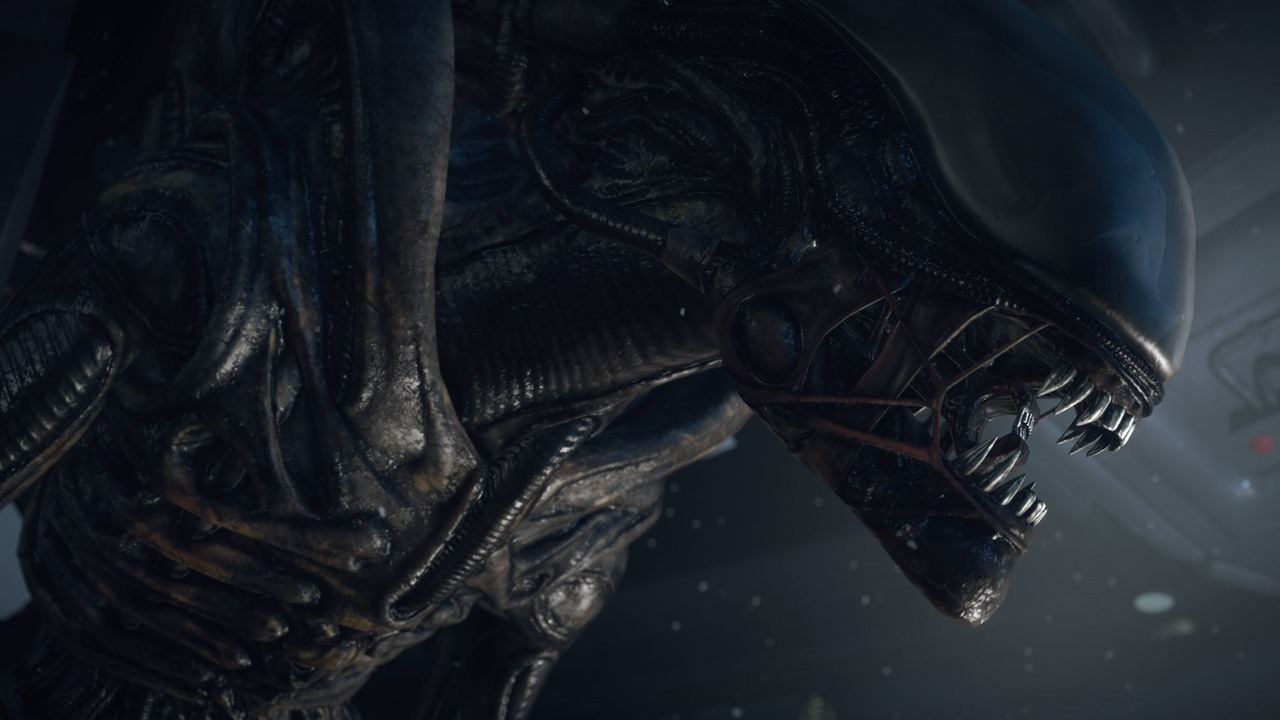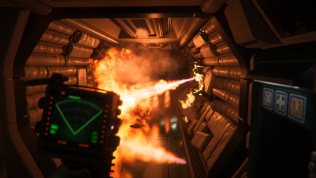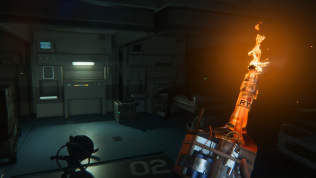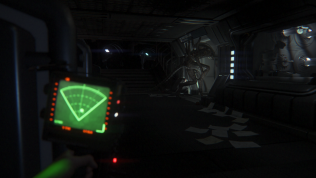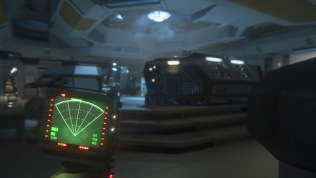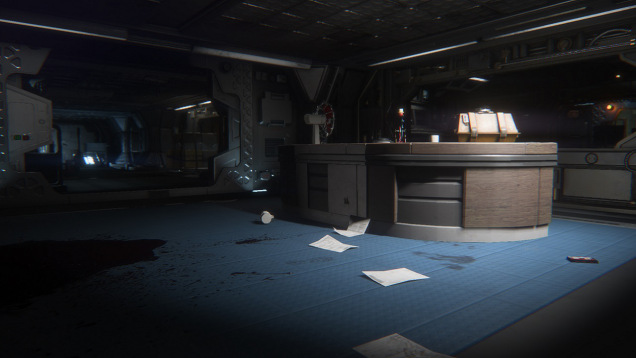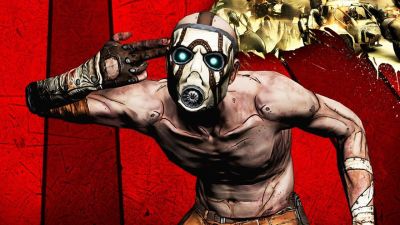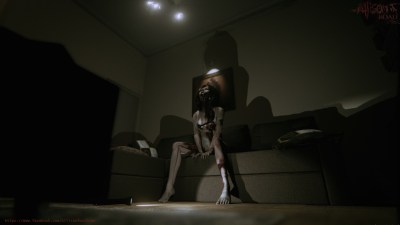Aliens: Colonial Marines was something of a mess, it’s fair to say. In the aftermath of its release and the subsequent backlash, Sega found itself in a sticky situation - and a court case surrounding the entire debacle is still ongoing; so the fate of the Alien franchise rested solely on the shoulders of the famed Total War developer The Creative Assembly.
For years they had already been working in secret on their homage to the Ridley Scott’s original film, collecting terrabytes of data from Fox’s archive vaults to craft an experience authentic to the cinematic experience Scott birthed back in 1979. But the timing of Gearbox’s ill-fated entry into the gaming sphere added an extra weight of responsibility on The Creative Assembly’s shoulders. While the world reeled from the more than disappointing Colonial Marines - which reduced Giger’s creature to nothing more than cannon fodder - the small team over at The Creative Assembly wanted to bring the scares back to the series.
They succeeded.
Dale already wrote, back in his March preview, that Alien: Isolation is a very different beast to some of the catastrophes that have sullied the property over the years. While many games increasingly use James Cameron’s action-dominated Aliens as inspiration for gameplay, Alien: Isolation does things very differently - requiring you to avoid, not confront Giger’s hideous creation, and removing any tools which might empower the player to sufficiently undermine the sense of ever-present threat posed by the infamous monster.
However, after the many recent Alien blunders that fans have been subjected to over the last decade, I entered into Isolation as a skeptic. Throughout my childhood, I frequently asked myself whenever I watched an Alien film: “who in their right mind would design these places?” Now, as I walk through the derelict ruins of what was once the Sevastopol Android Production Space Station, I’m called back to that same question as my childhood fears resurface from their long-dormant slumber.
I’ve long since overcome my fear of H.R Giger’s creation, with their horrifying appearance and chest-bursting birth. But I will never forget how I felt when I first watched those movies, the terror that kept me awake for days - the fear that at any moment they would come through the walls or unfurl from the ceiling to take me away. The nights were the worst because, lets face it, they mostly come at night.
Playing as Amanda Ripley - daughter of Ellen - you’re lured to the Sevastopol space station on the promise of finally finding out what happened to her mother after the events surrounding the destruction of the Nostromo. Much like her mother, Amanda is a capable engineer who generally keeps her head about her even as she’s being hunted by the Alien and chased by synthetics.
Amanda’s arrival on the station is disastrous: separated from her crew following a convenient disaster in the opening moments of the game, she’s left to sort through the mess resulting from the mass hysteria provoked by the outbreak. Synthetics - the Alien universe’s term for androids - are also on the loose, and often provide some of the more unsettling lines of dialogue in the game. Nothing is as scary as a calm and rational robot asking you nicely not to run in the halls while it chokes the life out of you.
The Sevastopol feels more alive than any game environment in recent memory; it shakes, creaks, and groans from gravitational stress as it slowly falls towards the gas giant it orbits. Every room, hallway, nook, and cranny you enter has a contextualized purpose outside of a game environment reminiscent of the original journey to Bioshock’s Rapture - or perhaps more fittingly, System Shock 2‘s Von Braun.
The chairs that litter the floors of the mess halls are not there because a game designer put them there; they’re there because someone knocked them over in a hurry to escape from a real danger. Barricades have been erected, doors locked, and the power is failing. Bodies are so rare that when you do happen to find one - that hasn’t been taken by the creature or “cleaned up” by the synthetics on board – it carries more weight than a mountain of corpses.
The Sevastopol Station, and Isolation proper, also has a lot in common with Dead Space’s Ishimura and The Sprawl, much in the same way that Dead Space has a lot in common with the Alien films. In Dead Space (the first two, at least) you arrive at a macabre and outdated space station that has been beset by an extraterrestrial threat, and those within have succumbed to their internal fears. The tropes of the genre shine as the walls are painted with bloody messages, rooms are filed with audio logs, and ominous reports litter the floors, all weaving a gruesome tale of the past week’s events. But it’s all executed in such a way way that it works; the environment tells as much of a story as the more overt narrative. Your mind fills in the gaps between what you are told and what you are shown to create a sense of dread surrounding the rapid downfall of order.
The Creative Assembly may have called this game Isolation, but you are never truly alone. The developer has wisely restrained themselves and withheld the monster back from being a true threat for the better part of the first three hours of the game. But once the terror starts it doesn’t stop. The creature will be your constant companion throughout the next 15 or so hours of the game, and it’s utterly relentless.
Weapons do nothing but scare it away or, worse, enrage it to attack; your only course of action is to avoid detection and remain hidden. It’s best to keep a constant eye on your motion detector as there’s rarely a moment when the creature cannot sneak up behind you. Elsewhere, there are human and synthetic enemies to contend with, as well as the occasional survivor to help drive the plot forward and dole out your next objective.
The Synthetics in Isolation embody the rough-and-ready approach that defines the Sevastopol-owing Seegson Corporation. Simply put, if Weyland Yutani is the Fairway of futuristic consumer goods, Seegson is the Walmart.
Both corporations offer goods with the same basic functions, but Seegson’s product lines are defined by function over form. Forget Ash, the almost indistinguishable-from-human synthetic from the first Alien film; here, the Synthetics exhibit no individuality in either appearance or behaviour, instead possessing a waxen, menacing stare and speaking as though they are reading from a crib-borrowed from the call center of your worst nightmares.
Sadly, the AI of both human and synthetic opponents is lacking, and the presentation of them leaves a lot to be desired. With the Synthetics, this is easier to forgive - they’re robots, after all. But the human characters reside firmly in the uncanny valley: their lips move out of sync with the words flowing from their mouths, and they blindly stare at a fixed point in space instead of talking directly to the player. Thankfully, the voice-acting and scripting throughout is, if not stellar, competent enough to not detract too much from the overall experience. But it’s clear that the Alien is the star of the show here, and The Creative Assembly has lavished as much of their attention - and budget - on making it as convincing, frightening and imposing a figure as possible.
Once the Alien enters the area and is alerted to your - or anyone’s - presence, it won’t leave you alone for some time. The Alien doesn’t act like a guard in Metal Gear Solid, investigating a noise for few moments before deciding it must have been a rat and returning to their routine. The Alien learns, it investigates, and it doesn’t forget what drew it out from its hiding place until it’s satisfied there’s nothing for it to kill.
Should the Alien ever catch you out in the open, you should consider yourself dead. The creature will not hesitate to instantly kill you with extreme prejudice - even if you’re waiting patiently for your game to save, or reading an email on one of the many terminals dotted around the station. Be prepared to die, you will do so with greater frequency than in any AAA game of recent years. This is partially because The Creative Assembly has crafted Isolation so that the Alien runs solely on its AI routines, with as few scripted events as possible. There’s a level of uncertainty that prevails throughout the game; every time you round a corner, the Alien could be there - or it could be absent. The tension comes from not knowing, and every time you reload a save the outcome could be different.
Your best bet when dealing with the Alien is to use your wide array of crafted devices to distract or scare it in any way possible. From molotov cocktails to noisemakers, you can find materials for crafting these tools in various caches throughout the rooms and halls of the Sevastopol. It pays to scavenge; materials and bullets are scare, but should you ever get in a pinch there is always the franchise-favorite weapon - the flame thrower. Fire is one of the only things that seems to scare off the monster, but you’re advised to keep your finger loose on the trigger, as fuel burns out quick.
The uncertainty and anxiety surrounding the omnipresent feeling of vulnerability is coupled with the fact that Isolation is a game about taking its precious time. Everything about Alien: Isolation is deliberate and methodical. Accessing computers, opening doors, hacking equipment, even saving all take up more time than they usually would in other games. This is a frequent complaint of many, that Alien: Isolation is about waiting, and the runtime is longer because of it. To the game’s critics, these aspects detract from the experience. But to me, this all builds into the tension that The Creative Assembly has crafted. From the moment I started playing to the moment the credits rolled some 20 hours later, I never felt safe - and the fact that tasks take a realistically longer time to accomplish leave you more exposed to the dangers within the world.
Alien: Isolation combines all of these mechanics to create a game that might actually be worse on hard mode than other games. Raising the difficulty does nothing but make the Alien more alert; On every difficulty setting you will meet a swift death from the hands – or tail – of the monster, and it’s always going to be a one-hit kill. A more alert Alien means you’ll be hiding in lockers or under desks for longer periods of time, and that can get tedious towards the latter half of the game, feeding into another complaint about Isolation - its length. But the length of any difficult game really comes down to personal skill level and playstyle. Isolation isn’t a game that you should sit down and power through, as you’ll quickly find yourself exhausted.
One of the major problems with Isolation’s length is that on more than one occasion the game continues past what would be a logical concluding point of the story, and at any one of these three specific points it would have been appropriate to roll the credits and call it a day. Instead, anything that can go wrong will go wrong and nothing is ever as straightforward as getting off the station before it crumbles. Isolation is set over the course of one day, and its length reflects that. It usually bothers me in a game when the story takes place over the course of a specific time frame, but it works in Isolation. Amanda Ripley has one hell of a bad day.
The Creative Assembly sat down to make a game that fits the style, aesthetic, and tone of the original Ridley Scott film and they hit it out of the park in doing so. Isolation is probably the first game since the release of the latest crop of consoles that has had the power to layer sounds, particles, and physics to create a deeply immersive world that pulled me in from the moment I started, and managed to sustain that immersion all the way through to the end. The restraint on using a minimalist musical score - inspired by Jerry Goldsmith’s work on the first film - is brilliant, and the soundscape and effects are spot on. More often than not you’ll find yourself navigating the environments with only sound of blaring alarms and the station crumbling around you for comfort.
For the first time in a long time I was scared of H.R. Giger’s creature, and developers tackling the franchise in future should take a closer look at Isolation. Fans of the original Bioshock and the first two Dead Space games will not miss out on Isolation. Pulling in aspects from Rapture, The Sprawl, and the Ishimura when it comes to world design, but remaining completely - almost slavishly - authentic to Scott’s original cinematic vision, The Creative Assembly has created a quality mainstream horror experience that should provide an easier barrier to entry into a genre usually reserved for the more hardened of players. It is more of an edge-of-your-seat stressful experience than an outright horror game like Silent Hill, but that doesn’t mean that Alien: Isolation isn’t scary. At times, it’s downright terrifying.
Giger’s Xenomorph has become an iconic Hollywood monster over the last 25 years, and there’s little mystery anymore behind what it is and where it comes from. Sega, and the Alien brand as a whole, needed this game to do well after so many misfires over the last decade. It’s refreshing to see The Creative Assembly stick to the genre without deviating too far from the survival horror path by curbing the difficulty. Isolation is full of health bars, save points, and a relentless experience that harkens back to the games of yesteryear. Perhaps more developers should follow suit.
I may have come into Alien: Isolation as a skeptic, but within the opening few minutes I was completely on board. Often I found myself escaping a situation by the skin of my teeth with a rushed panic, followed by several audible “ohcrapohcrapohcrap” utterances. Rarely does a game manage to induce genuine panic, but Isolation completely nails the feeling of pure tension and suspense which defines the original film.
Alien: Isolation is not just the best Alien game in years; it’s also one of the best horror games in years, full stop.
